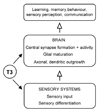Multigenic control of thyroid hormone functions in the nervous system
- PMID: 18448240
- PMCID: PMC2486256
- DOI: 10.1016/j.mce.2008.03.006
Multigenic control of thyroid hormone functions in the nervous system
Abstract
Thyroid hormone (TH) has a remarkable range of actions in the development and function of the nervous system. A multigenic picture is emerging of the mechanisms that specify these diverse functions in target tissues. Distinct responses are mediated by alpha and beta isoforms of TH receptor which act as ligand-regulated transcription factors. Receptor activity can be regulated at several levels including that of uptake of TH ligand and the activation or inactivation of ligand by deiodinase enzymes in target tissues. Processes under the control of TH range from learning and anxiety-like behaviour to sensory function. At the cellular level, TH controls events as diverse as axonal outgrowth, hippocampal synaptic activity and the patterning of opsin photopigments necessary for colour vision. Overall, TH coordinates this variety of events in both central and sensory systems to promote the function of the nervous system as a complete entity.
Figures





References
-
- Abe T, Suzuki T, Unno M, Tokui T, Ito S. Thyroid hormone transporters: recent advances. Trends in Endocrinol. and Metab. 2002;13:215–220. - PubMed
-
- Anderson GW, Hagen SG, Larson RJ, Strait KA, Schwartz HL, Mariash CN, Oppenheimer JH. Purkinje cell protein-2 cis-elements mediate repression of T3-dependent transcriptional activation. Mol Cell Endocrinol. 1997;131:79–87. - PubMed
Publication types
MeSH terms
Substances
Grants and funding
LinkOut - more resources
Full Text Sources

